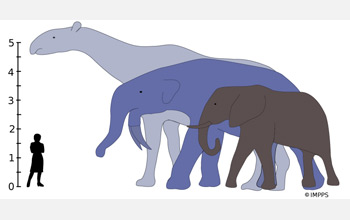News Release 10-224
Mammals Grew 1,000 Times Larger After the Demise of the Dinosaurs
NSF enabled the assembly of an international, interdisciplinary team that was the first to quantitatively document body size patterns over the past 100 million years

The largest land mammals that ever lived would have towered over the living African Elephant.
November 25, 2010
View videos of Felisa Smith from the University of New Mexico explaining the discovery and research.
This material is available primarily for archival purposes. Telephone numbers or other contact information may be out of date; please see current contact information at media contacts.
Researchers have demonstrated that the extinction of dinosaurs some 65 million years ago paved the way for mammals to get bigger, about a thousand times larger than they had been when dinosaurs roamed the earth. The study, released today in the journal Science, is the first to quantitatively document the patterns of body size of mammals after the existence of dinosaurs.
The research, funded by a National Science Foundation (NSF) Research Coordination Network (RCN) grant, led by Principal Investigator Felisa Smith of the University of New Mexico, brought together an international team of paleontologists, evolutionary biologists and macroecologists from universities throughout the United States and around the world.
RCN grants began in NSF's Directorate for Biological Sciences to encourage and foster communications and collaborations among scientists with common goals and interests. Groups of investigators are supported to communicate and coordinate their research efforts across disciplinary, organizational, institutional and geographical boundaries. The proposed networking activities each focus on a theme: a broad research question, a specific group of organisms, or particular technologies or approaches. Innovative ideas for implementing novel networking strategies to promote research coordination and collaboration that enable new research directions or advancement of a field are especially encouraged. What results are diverse, multi-disciplinary research teams that harness and synthesize different insights and data to achieve new, exciting discoveries.
"The findings on mammal size detailed in Science are evidence of the value of coordination networks, and of their success in bringing together scientists who have not worked together in the past," said NSF Program Manager Saran Twombly. "Smith's group had combined data in a new synthesis to advance our understanding of the evolution of body size."
Based on the success of research funded by RCN grants in NSF's Directorate for Biological Sciences, the program has been replicated in other directorates and offices throughout the foundation, including the directorates for Mathematical & Physical Sciences; Geosciences; Education & Human Resources and Social, Behavioral and Economic Sciences; as well as the offices of Polar Programs, International Science and Engineering, and Cyberinfrastructure.
For more detail about this discovery, read the University of New Mexico's press release.
-NSF-
-
View Video
Listen to principal investigator Felisa Smith describe the discovery.
Credit and Larger Version -
View Video
Listen to Felisa Smith describe her research team and its method for synthesizing data.
Credit and Larger Version -
This research is described in the Nov. 26 issue of Science.
Credit and Larger Version
Media Contacts
Lisa-Joy Zgorski, NSF, (703) 292-8311, email: lzgorski@nsf.gov
Steve Carr, University of New Mexico, (505) 277-1821, email: scarr@unm.edu
Program Contacts
Saran Twombly, NSF, (703) 292-8133, email: stwombly@nsf.gov
Principal Investigators
Felicia Smith, University of New Mexico, (505) 277-6725, email: fasmith@unm.edu
Related Websites
Solicitation for NSF Research Collaboration Networks: http://www.nsf.gov/pubs/2010/nsf10566/nsf10566.htm
University of New Mexico Press Release Announcing The Evolution of Giant Mammals: http://news.unm.edu/news-releases/
The U.S. National Science Foundation propels the nation forward by advancing fundamental research in all fields of science and engineering. NSF supports research and people by providing facilities, instruments and funding to support their ingenuity and sustain the U.S. as a global leader in research and innovation. With a fiscal year 2023 budget of $9.5 billion, NSF funds reach all 50 states through grants to nearly 2,000 colleges, universities and institutions. Each year, NSF receives more than 40,000 competitive proposals and makes about 11,000 new awards. Those awards include support for cooperative research with industry, Arctic and Antarctic research and operations, and U.S. participation in international scientific efforts.
Connect with us online
NSF website: nsf.gov
NSF News: nsf.gov/news
For News Media: nsf.gov/news/newsroom
Statistics: nsf.gov/statistics/
Awards database: nsf.gov/awardsearch/
Follow us on social
Twitter: twitter.com/NSF
Facebook: facebook.com/US.NSF
Instagram: instagram.com/nsfgov





